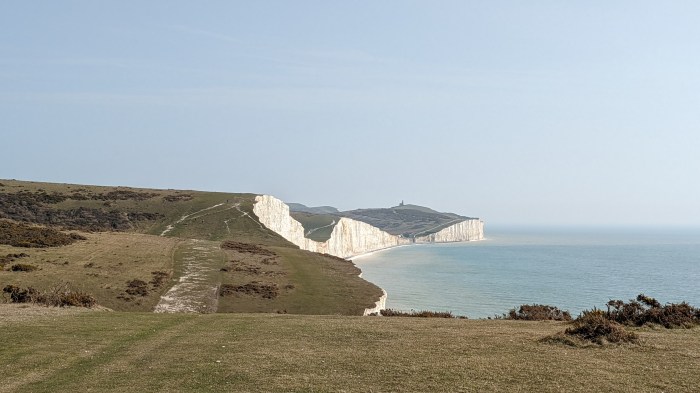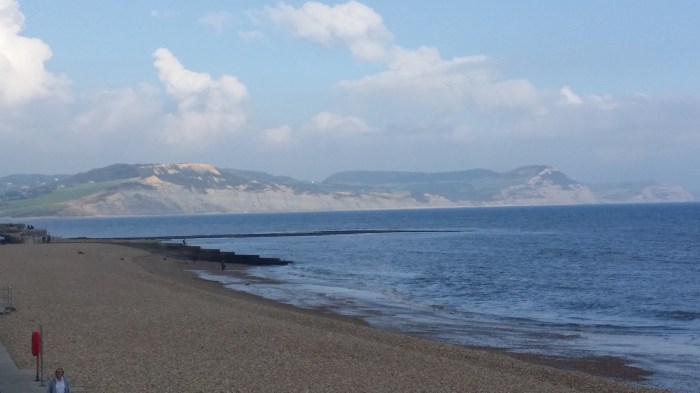The National Trails of England and Wales are a set of waymarked and promoted long distance paths across some of the most stunning scenery in the country. They are Government designated and managed to a set of quality standards that set them above other trails. They are funded by Natural England or Natural Resources Wales, along with relevant local authorities and other partners. As many pass through National Parks or AONBs those agencies are also involved in looking after them.
National Trails are the premier category of trails in England and Wales. In Scotland the equivalent is Scotland’s Great Trails, although these include a lot of small trails too (see separate page for the Scottish trails).
Each National Trail has a dedicated Trail Officer and a team that supports the maintenance of the trail. Some of the trails also have Ambassadors, trained to promote and lead events along them. I myself am an Ambassador for the North Downs Way National Trail.
The first trail was the Pennine Way, opened in 1965. The newest, at time of writing, is the England Coast Path, which is being opened in stages – for details of the sections which are open, refer to the national trails website. When complete, the England Coast Path at around 4,500km long will be the longest coastal walking trail in the world.
There is a proposal for Wainwright’s Coast to Coast, currently an unrecognised and largely unwaymarked trail, to become a National Trail – this was announced in August 2022 but will take several years to come to fruition.
National Trails are marked with an acorn symbol, and generally accompanied by normal local rights of way signage (e.g. a footpath along a National trail will commonly be signed with the acorn and a yellow arrow).
The Trails
| Trail | Opened | Length | Typical Time Needed |
|---|---|---|---|
| Cleveland Way | 1969 | 109 miles / 175 km | 9 days |
| Coast to Coast | Scheduled for 2025 | 197 miles / 317 km | 12 days |
| Cotswold Way | 2007 | 102 miles / 164 km | 7-10 days |
| England Coast Path | 2012 onwards | 2,795 miles / 4,500 km | Many months |
| Glyndŵr’s Way | 2002 | 135 miles / 217 km | 9 days |
| Hadrian’s Wall Path | 2003 | 84 miles / 135 km | 6-7 days |
| North Downs Way | 1978 | 153 miles / 246 km | 12 days |
| Offa’s Dyke | 1971 | 177 miles / 285 km | 14 days |
| Peddars Way and Norfolk Coast Path | 1986 | 133 miles / 214 km | 8 days |
| Pembrokeshire Coast Path | 1970 | 186 miles / 299 km | 12 days |
| Pennine Bridleway | 2012 | 205 miles / 330 km | 15 days |
| Pennine Way | 1965 | 268 miles / 431 km | 16-19 days |
| South Downs Way | 1972 | 100 miles / 160 km | 8-9 days |
| South West Coast Path | 1978 | 630 miles / 1014 km | 7-8 weeks |
| Thames Path | 1996 | 185 miles / 298 km | 14 days |
| The Ridgeway | 1973 | 87 miles / 139 km | 6 days |
| Yorkshire Wolds Way | 1982 | 79 miles / 127 km | 5-6 days |
National Trails Completed
I am working my way through the National Trails, with the aim of walking them all – with the possible exception of the England Coast Path, which may not be achievable given its length and the fact that it will take several years to be completed.
The National Trails I have already walked are:
NORTH DOWNS WAY (JUNE 2016)
The North Downs Way runs along a ridge of chalk from Farnham in Surry to Dover, splitting into two arms at Wye near Ashford. The trail is 153 miles or 246km long, and alternates between walking along the top of the escarpment and at the foot, where much of the ancient Pilgrims Way lies. It passes through two AONBs – Surrey Hills and Kent Downs.


GLYNDŴr’s Way (AUGUST 2021)
One of the newer National Trails, this one connects various places in Mid-Wales associated with Owain Glyndŵr. It’s a pleasant meander across Wales and back again, with both ends of the trail connecting with Offa’s Dyke National Trail, providing a means of making this a circular walk if desired.
South Downs Way (March 2022)
The South Downs Way is 100 miles or 160km long, running from Winchester in Hampshire to Eastbourne in East Sussex, mostly following the chalk ridge. It has a more airy and high level feel than the North Downs Way, with the highlight being the final section over the Seven Sisters.


Yorkshire Wolds Way (August 2022)
At 79 miles or 127km the Yorkshire Wolds Way is the shortest one on the list, winding its way up through the western side of the Yorkshire Wolds from Hessle on the Humber to the coast at Filey Brigg.
South West Coast Path (June 2008 – )
Currently (until the England Coast Path is complete) the longest National Trail at 630 miles or 1,014 km, the SWCP runs from Minehead along the coast of Somerset, Cornwall, Devon and Dorset to South Haven Point near Poole.

GuidebookS AND NAVIGATION
As the leading trails in the country, there is generally a good selection of guidebooks for the National Trails from various publishers – although it should be noted that not every publisher produces a book for every National Trail.
First and foremost there are the official guides, published by Aurum Press. Companies such as Trailblazer, Cicerone etc also produce comprehensive guides for most of the National Trails – which of these you choose is likely a matter of personal preference (I like the Trailblazer guides, as they have sketch maps showing features and services along the trail, which make them useful when used in conjunction with an OS map).

All of the trails are generally well waymarked, with the acorn symbol and local rights of way signage. On some trails, local signage also includes things such as OS Grid References on stiles, gates etc, which can be really useful too.
Many of the National Trails also coincide with local trails, and it is not unusual to find stretches of trail where several paths align with each other. Care does need to be taken to take the right direction when they split again!
It should also be noted that some of the existing National Trails have sections running along the coast, and therefore, coincide with the England Coast Path. Care needs to be taken to spot when to leave the coast again as the acorn will be used for both trails.
The best website for researching the National Trails, and the place to start planning any attempt on one of the trails is nationaltrail.co.uk

